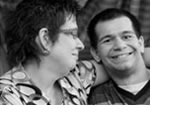Newly Diagnosed
- Details
-
Last Updated: Wednesday, 19 October 2016 10:34
Adult Late Onset
Tay-Sachs, Sandhoff and GM1 diseases
I have, or someone I love, has just been diagnosed with Late Onset (LOTS) Tay-Sachs, Sandhoff or GM-1, now what?
Take a deep breath and know that you've come to the right place. You've likely been on a long road to diagnosis and now you finally have an answer, but now what?
NTSAD can help you:
- Understand the diagnosis and symptom management options
- Keep updated on research efforts
- Connect with other individuals and families that truly understand
Getting Started:
- Contact Diana Pangonis, Director of Family Services at This email address is being protected from spambots. You need JavaScript enabled to view it. or (800) 906-8723.
- Read the Newly Diagnosed pages
- Share the
pdf
LOTS Medication Study
(60 KB)
with your treating physician.
- Contact Diana anytime with questions, issues and/or concerns.
First Steps for Late Onset
- Details
-
Last Updated: Wednesday, 29 April 2015 15:24
Late Onset first steps
Tay-Sachs, Sandhoff and GM1 diseases
A diagnosis of Late Onset is overwhelming. Taking action is a great way to cope and prepare for the changes down the road. Putting these things in place will simplify managing the disease giving you more time to enjoy life.
Follow these 5 steps:
1. Get Organized
Make a folder or notebook for all the information related to LOTS. Many find it convenient to buy a three-inch/three-ring binder notebook and use dividers for the various sections of assessment, treatment, resources, therapy and correspondence. Electronic files can help keep you organized - be sure to keep the files backed-up.
The following information should be kept in the notebook.
- Where the evaluation/assessment was done, where diagnosis was made
- Names and contact information of doctors
- Informative hand-outs
- Supportive resources
- Pertinent phone numbers and addresses
- Copies of assessment reports, diagnostic and imaging tests laboratory reports and medications
When the notebook is full, write the date on the cover and start another notebook. These notebooks will make it possible for you to look up information about your child. Take the notebooks with you to every appointment and keep them up-to-date.
2. Learn about Government Resources
Visit these sites to become familiar with available resources.
Social Security Disability
http://www.ssa.gov/pgm/disability.htm
Supplemental Security Income (SSI)
http://www.ssa.gov/pubs/11000.html#part1
Medicare and Medicaid are two different programs and you may be eligible for both. Medicaid is a state-run program; each state has its own eligibility and coverage rules.
Visit this site for more information on Medicaid
Visit this site for more information on Medicare.
3. Find the Right Doctor
It is more important to find a treating physician or neurologist who you are comfortable with than one who has LOTS experience. Due to the rarity of the disease finding a local doctor with LOTS experience is often difficult. Instead, try to find a doctor who will work with you to manage the disease and consult with expert clinicians on the NTSAD Scientific Advisory Committee (SAC) as needed.
It is important that you:
- Are comfortable with the doctor and healthcare team
- Are able to communicate your questions and concerns
- Feel supported in your efforts to manage the disease
- Are confident the doctor and healthcare team are partners in insurance coverage issues
The relationship with the doctor and healthcare team is a critical component of successfully managing LOTS, particularly because there have no sure-fire answers and a wide range of severity and symptoms.
4. Understand Your Policy
Familiarize yourself with the coverage offered by your current insurance policy. You will be in a far better position to advocate for yourself if you have spent time getting to know the basic elements of your plan, including:
- Eligibility requirements - who is covered under what circumstances
- Benefits - which services/treatments are specifically included or excluded and what are the limits on the coverage provided
- Regulatory information - who is responsible for enforcing the provisions of the plan, and to whom would appeals be addressed if needed
- Grievance procedures - what is the grievance/appeal process
5. Request an Insurance Case Manager
A case manager will become familiar with your particular medical needs and help you navigate the insurance policy to get the best coverage possible. Sometimes it is possible to negotiate the coverage; give up one type of coverage you likely will not need for another you do. It will also save you from having to explain the diagnosis repeatedly when calling the insurance company for coverage information.



 This page describes:
This page describes: